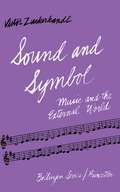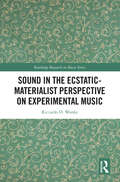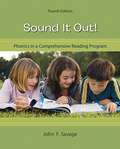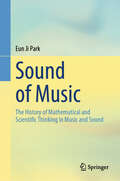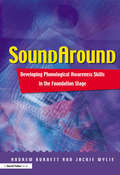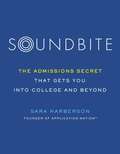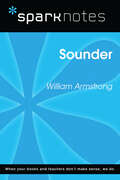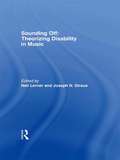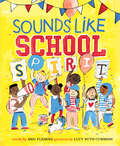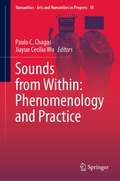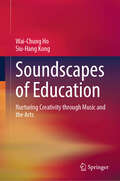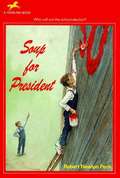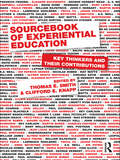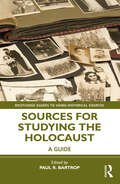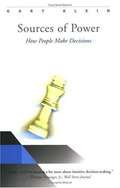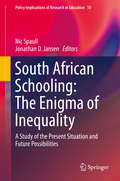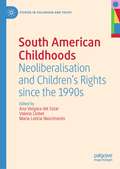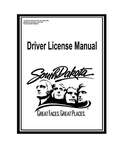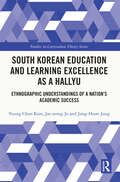- Table View
- List View
Sound and Symbol, Volume 1: Music and the External World (Bollingen Series (General) #655)
by Victor ZuckerkandlAn approach to music as an instrument of philosophical inquiry, seeking not so much a philosophy of music as a philosophy through music.
Sound in the Ecstatic-Materialist Perspective on Experimental Music (Routledge Research in Music)
by Riccardo D. WankeWhat does a one hour contemporary orchestral piece by Georg Friedrich Haas have in common with a series of glitch-noise electronic tracks by Pan Sonic? This book proposes that, despite their differences, they share a particular understanding of sound that is found across several quite distinct genres of contemporary art music: the ecstatic-materialist perspective. Sound in the ecstatic-materialist perspective is considered as a material mass or element, unfolding in time, encountered by a listener, for whom the experience of that sound exceeds the purely sonic without becoming entirely divorced from its materiality. It is "material" by virtue of the focus on the texture, consistency, and density of sound; it is "ecstatic" in the etymological sense, that is to say that the experience of this sound involves an instability; an inclination to depart from material appearance, an ephemeral and transitory impulse in the very perception of sound to something beyond – but still related to – it. By examining musical pieces from spectralism to electroacoustic domains, from minimalism to glitch electronica and dubstep, this book identifies the key intrinsic characteristics of this musical perspective. To fully account for this perspective on sonic experience, listener feedback and interviews with composers and performers are also incorporated. Sound in the ecstatic-materialist perspective is the common territory where composers, sound artists, performers, and listeners converge.
Sound it Out!: Phonics in a Comprehensive Reading Program (Fourth Edition)
by John F. SavageThis book covers both the content of phonics and the ways in which it can be effectively integrated into a comprehensive classroom reading program. The text contains practical teaching suggestions for phonemic awareness, phonics, and spelling. The fourth edition features an increased emphasis on technology as it applies to phonics instruction, along with additional focus placed on helping children who have trouble learning acquire basic phonics skills.
Sound of Music: The History of Mathematical and Scientific Thinking in Music and Sound
by Eun Ji ParkThis book explains that the essence of music lies in intangible mental realms. While vibrations generate sound, and sound forms music, music represents something far beyond mere phenomena—a higher form of expression. This book describes how vibrations are transmitted to the human ear, stirring emotions and ultimately moving the soul. This complex process defies full comprehension. Nevertheless, humanity has long sought to uncover the secrets of music and sound, striving since ancient times to objectively interpret them. This book begins by exploring this endeavor as both a way of observing phenomena and attempting to understand the world, posing the following questions: How have we interpreted music and sound throughout history? What origins have we ascribed to music and sound? How have we analyzed sound phenomena with different technologies up to the present day? Throughout history, scholars have observed and analyzed music and sound from different perspectives, initially seeking to understand sound through numerical frameworks and later employing scientific experimentation to analyze it more precisely. The observations and theories discovered along the way have established a rich body of knowledge, enabling us to accurately understand sound phenomena through mathematics and science. This book emphasizes that the artistic domain of music and the scientifically analyzed realm of sound are bound in an inseparable, symbiotic relationship. It argues that those who truly wish to understand music must acquire knowledge of sound. The quality of sound (La qualité du Son), as this book demonstrates, plays a crucial role in shaping the emotional impact of music, with listeners&’ experiences varying significantly based on sound quality. In some respects, sound itself may play an even more important role than any other aspect in forming music. Ultimately, this book provides foundational knowledge of music and sound from diverse perspectives while explaining their connections within the historical contexts of music and science.
Soundaround: Developing Phonological Awareness Skills in the Foundation Stage
by Andrew Burnett Jackie WylieThis practical and clear book will allow you to introduce and teach phonological awareness skills to children in the early years and up to Key Stages 1 to 2, who are struggling with their literacy levels because of weak basic skills. It provides a developmental and curriculum linked program suitable for all children, including those with special educational needs; a straightforward format that does not require specialist training yet enables staff to choose activities and confidently use them from day one; a focus on 'sounds first' leading to secure learning based on normal child development; activities which children enjoy and want to play again; and ideal preparation for literacy work at school. All staff involved with children in the Foundation Stage (and sometimes beyond) including teachers, nursery nurses, playgroup staff, SENCOs, teaching assistants, speech and language therapists and parents will be able to improve their children's early literacy skills using this approach.
Soundbite: The Admissions Secret that Gets You Into College and Beyond
by Sara HarbersonCrack the code to college admissions and help students craft the ultimate statement of self-identity and get into their school of choice with this groundbreaking guide from America's College Counselor.On average, an admissions committee takes seconds to decide whether to admit a student. They must sum up the student in one sentence that will tell them if a student is going to be a good fit for their program.What is the best way to transform this admissions process from a stressful, pressure-cooker arms race into an empowering journey that paves the way to the best individual outcome?Written by a college admissions insider turned consultant, Soundbite guides parents and students through the admissions process from start to finish. Armed with her knowledge of how the system works, Sara Harberson shares tried-and-tested exercises that have helped thousands of students gain admission to their school of choice. The soundbite, her signature tool, presents an opportunity for students to take the reins to craft their ultimate statement of self-identity and formulate their own personal definition of what is best. With this soundbite in place as their foundation, students achieve maximum impact when they present themselves to colleges. In doing so, the tables are turned: the student's fate no longer rests on a soundbite composed by an admissions officer. Instead, the student employs their own soundbite to define themselves on their own terms. Soundbite shifts the way we talk about the admissions process—from "Getting You In" to "Getting the Best You In."
Sounder (SparkNotes Literature Guide Series)
by SparkNotesSounder (SparkNotes Literature Guide) by William Armstrong Making the reading experience fun! Created by Harvard students for students everywhere, SparkNotes is a new breed of study guide: smarter, better, faster. Geared to what today's students need to know, SparkNotes provides: *Chapter-by-chapter analysis *Explanations of key themes, motifs, and symbols *A review quiz and essay topicsLively and accessible, these guides are perfect for late-night studying and writing papers
Sounding Off: Theorizing Disability In Music
by Neil Lerner Joseph N. StrausDisability, understood as culturally stigmatized bodily difference (including physical and mental impairments of all kinds), is a pervasive and permanent aspect of the human condition. While the biology of bodily difference is the proper study for science and medicine, the meaning that we attach to bodily difference is the proper study of humanists. The interdisciplinary field of Disability Studies has recently emerged to theorize social and cultural constructions of the meaning of disability. Although there has been an astonishing outpouring of humanistic work in Disability Studies in the past ten years, there has been virtually no echo in musicology or music theory. Sounding Off: Theorizing Disability in Music is the first book-length work to focus on the historical and theoretical issues of music as it relates to disability. It shows that music, like literature and the other arts, simultaneously reflects and constructs cultural attitudes toward disability. Sounding Off: Theorizing Disability in Music promises to be a landmark study for scholars and students of music, disability, and culture.
Sounds Like School Spirit
by Meg FlemingThe ultimate back-to-school ode, this interactive, cheer-filled picture book joyfully celebrates the community we build at schoolThey have spirit, yes they do! Follow kids from circle time to the lunch line in this lively, rhyming picture book that perfectly matches the high energy of a new classroom. With a call and response like "We say ALPHA, you say BET," built into the text, kids will love reading and cheering along.
Sounds from Within: Phenomenology and Practice (Numanities - Arts and Humanities in Progress #18)
by Paulo C. Chagas Jiayue Cecilia WuThis book transforms phenomenology, music, technology, and the cultural arts from within. Gathering contributions by performing artists, media technology designers, nomadic composers, and distinguished musicological scholars, it explores a rich array of concepts such as embodiment, art and technology, mindfulness meditation, time and space in music, self and emptiness, as well as cultural heritage preservation. It does so via close studies on music phenomenology theory, works involving experimental music and technology, and related cultural and historical issues. This book will be of considerable interest to readers from the fields of sound studies, science and technology studies, phenomenology, cultural studies, media studies, and sound art theory. This book is equally relevant and insightful for musicians, composers, media artists, sound artists, technology designers, and curators and arts administrators from the performing and visual arts.
Soundscapes of Education: Nurturing Creativity through Music and the Arts
by Wai-Chung Ho Siu-Hang KongThis book focuses on nurturing students&’ creativity through the integration of music and other creative art forms. It presents the soundscape as an immersive auditory environment that surrounds us, capable of evoking emotions, stimulating imagination, and inspiring creative thought. By actively engaging with the soundscape while listening to music or the sound environment, individuals can enhance their creative experiences and discover new avenues for exploration and expression in teaching. Additionally, the book explores creativity within the soundscapes of diverse cultures, broadening students&’ perspectives, while promoting cultural awareness, empathy, and interconnectedness. The book pays particular attention to the Chinese community while considering its relevance in both Western and non-Western contexts. It emphasizes the influential role of teachers and the social environment in motivating creativity and creative behaviour, risk-taking, and innovative problem-solving skills. The book also showcases a comprehensive programme with resources for facilitating creative music-making, providing detailed insights into how creativity can be effectively sustained, stimulated, and promoted within the education system.
Soup for President
by Robert Newton PeckEveryone in Miss Kelly's class is excited about the upcoming election for school president. The good news is that Rob's best friend, Soup, is the boys' candidate, and the bad news is that the girls' candidate is Rob's sweetheart, Norma Jean Bissell. Soup is sure he's a cinch to win with Rob as his campaign manager and schemes up some exciting and dangerous advertising, never thinking about the consequences.
Source Criticism on the Schedule: Teaching Critical Thinking (Springer Texts in Education)
by Anna Rosenqvist Stefan EkecrantzThis textbook is a practical and theoretical teacher guide on how to develop critical thinking and source criticism in contemporary elementary and secondary education, which requires students to develop their critical thinking from different perspectives as well as to develop their ability to critically evaluate sources they use for school-related work. What can a teacher do to support such development? The authors discuss several different perspectives on how one, as a teacher, can think about and work with source criticism together with the students. In the first part of the book a theoretical background and a principled discussion of critical thinking are discussed. This includes psychological and philosophical perspectives on source criticism. In the second part there are concrete teaching examples and tips on how to work with source criticism in both primary and secondary school.
Sourcebook of Experiential Education: Key Thinkers and Their Contributions
by Thomas E. SmithExperiential education is a philosophy and methodology for building knowledge, developing skills, and clarifying values by engaging learners in direct experience and focused reflection. To understand experiential education, what should one be reading? This sourcebook introduces philosophers, educators, and other practitioners whose work is relevant to anyone seeking answers to this question. Following brief snapshots of John Dewey and Kurt Hahn, the book is organized in four sections: Philosophers and Educational Theorists Nature Educators and Outdoor Educators Psychologists and Sociologists School and Program Founders. Each chapter focuses on an individual whose philosophy and practice exemplify a biographical and historical model for reaching a deeper understanding of experiential education. An appendix includes short biographical sketches of forty-five additional people whose contributions to experiential education deserve a closer look. This volume provides a much-needed overview and foundations for the field – for students in courses addressing experiential education, challenge education, outdoor experiential education, recreation education, and related fields; for learning theorists and curriculum specialists; for experiential educators; and for educational philosophers.
Sources Say
by Lori GoldsteinTwo exes. One election. All the drama.For fans of Becky Albertalli and Morgan Matson comes a funny, heartfelt novel about feuding exes running for class president and the scandal that makes the previously boring school election the newest trending hashtag.At Acedia High, student council has always been a joke. Nobody pays attention. Nobody cares. But that changes when someone plasters the halls with Photoshopped images of three &“perfect tens&”—composites of scantily clad girls made from real photos of female students at the school. Quickly dubbed the &“Frankengirls,&” the scandal rocks the student body. And the two presidential candidates, budding influencer Angeline Quinn and charming jock Leo Torres, jump on the opportunity to propose their solutions and secure votes. Fresh from a messy public breakup, Angeline and Leo fight to win, and their battle both mesmerizes and divides the school. The election fills the pages of The Red and Blue, the school newspaper run by Angeline&’s sister, Cat. The Quinn sisters share a room and a grade but little else, and unlike her more sensationalist sister, Cat prides herself on reporting the facts. So when a rival newspaper pops up—written by an anonymous source and the epitome of &“fake news&”—Cat&’s journalistic buttons are pushed. Rumors fly, secrets are leaked, and the previously mundane student election becomes anything but boring.
Sources for Studying the Holocaust: A Guide (Routledge Guides to Using Historical Sources)
by Paul R. BartropSources for Studying the Holocaust provides a pathway for readers to engage with questions about what sources can be used to study the Holocaust. For many historians, the challenge has been how to rescue the story from oblivion when oft-used sources for other periods of history introduce even more issues around authenticity and reliability. What can be learned of what transpired in villages and towns numbering several thousand people, when all its Jewish inhabitants were totally obliterated through Nazi action? Who can furnish eyewitness testimony, if all the eyewitnesses were killed? How does one examine written records preserving knowledge of facts or events, where none were kept or survived the onslaught? And what weight do we put upon such resources which did manage to endure the destruction wrought by the Holocaust? Each chapter looks at one of a diverse range of source materials from which scholars have rescued the history, including survivor testimony, diaries, letters, newspaper accounts, photographs, trial documents, artefacts, digital resources, memorials, films, literature, and art. Each chapter shows how different types of records can be utilised as accurate sources for the writing of Holocaust history. Collectively, they highlight the ways in which all material, even the most fragmentary, can be employed to recreate a reliable record of what happened during the Holocaust and show how all sources considered can be employed to find meaning and understanding by exploring a range of sources deeply. This book is a unique analysis of the types of sources that can be used to access the history of Holocaust. It will be of invaluable interest to readers, students, and researchers of the Holocaust.
Sources for a Better Education: Lessons from Research and Best Practices (Springer Texts in Education)
by Piet KommersThis textbook evolves from the intersection between ‘Research’, ‘Educational Information Technologies’ and recent ‘Best Practices’. It offers diplomacy and erudite rhetoric in order to harvest from innovation projects and see how new professional needs for teachers are emerging day by day. The volume launches the compact background for the 21st century education that every teacher faces after being in charge for 3 or 6 years after pre-service training. ‘Sources for a better education’ refers to the deep understanding and to the incentives for encouraging teachers to leave the comfort zone and experiment the next steps into a further sophisticated professionalism, without the threat of feeling in a ‘Dilemma’.The first candidate for extending one’s teaching effectiveness is to tailor one’s teaching to the test to be expected. ‘Teaching to the Test’ is an understandable tactic, however it endangers the students’ full understanding of underlying concepts and analogies. The second candidate for professionalism is the deeper layer of knowledge on how curricular domains are related. In simpler terms: better teachers know how to ‘bridge’ topics and subjects so that students develop a deeper understanding on the patterns and structure in knowledge. The 21st century education prioritizes higher degrees of flexible-, divergent and abstract thinking, so that creative problem solving comes into reach. ICT tools for making prior knowledge explicit is a major example on how learners harvest upon prior knowledge, thinking and intuition. The third source for a better education is the courage to envisage one’s meta knowledge in order to see patterns in learning and understanding. The more conscious prior knowledge gets decompiled into genetic metaphors; the better future learning can be anticipated. The fourth asset for meta-cognitive skills is the wide spectrum of tools that the web offers for building knowledge infra-structures so that knowledge becomes transformed into problem solving skills; the availability of knowledge is no longer sufficient for finding creative and authentic solutions in future situations. This is the case for both students and teachers. By tradition, the bottom-up strategy from reproductive factual learning up to the levels of problem solving and creative thinking has been favoured. The ‘one-click away’ access to information on the web asks a more strategic attitude from learners and practitioners to cope with the periphery between known and unknown, so that a more effective meta-cognition develops. The fifth stimulus for more effective learning is the expanding impact of social media. Social media tend to intimidate learners with incomplete understanding to jump on biases as delivered through political and conspiracy agendas. This books aims at the challenge to build upon learners’ existential needs and developing interest for a longer-term learning perspective.“Renaissance man and philosopher Piet Kommers presents us with an interesting question: What makes education exciting? His book covers a range of lessons learnt through research and practice, covering philosophies and paradoxes, ranging from learning to learn to machine learning for learning. In 35 chapters he takes us on an exciting, comprehensive journey of just about every conceivable aspect of technology and education. This is a must-have for every 21st Century bookshelf!” By: Johannes Cronjé, professor of Digital Teaching and Learning in the Department of Information Technology at the Cape Peninsula University of Technology, South Africa.“Piet Kommers has in 400 pages provided an overview of teaching based on practical experience. It is not a summary of pedagogic models, but a guide to important factors in how to motivate students and thus improve their learning. New technologies changes teaching, and we need to understand how application of such technologies can improve the learning. This book provides such knowledge and I wish I had it when I started teaching at university many years ago.” By: Jan
Sources of Power: How People Make Decisions
by Gary A. KleinSince 1985, Klein has conducted fieldwork to find out how people tackle challenges in difficult, nonroutine situations. Sources of Power is based on observations of humans acting under such real-life constraints as time pressure, high stakes, personal responsibility, and shifting conditions. The professionals studied include firefighters, critical care nurses, pilots, nuclear power plant operators, battle planners, and chess masters. Each chapter builds on key incidents and examples to make the description of the methodology and phenomena more vivid. In addition to providing information that can be used by professionals in management, psychology, engineering, and other fields, the book presents an overview of the research approach of naturalistic decision making and expands our knowledge of the strengths people bring to difficult tasks.
Sources of the West, Volume 2: From 1600 To The Present (8th Edition)
by Mark Kishlansky Ira J. Gordon William F. BreivogelRead the voices of the past to connect with the present. " "Kishlansky presents a well-balanced selection of readings that integrate coverage of social, economic, religious and cultural history within a traditional, political framework. "Sources of the West" includes documents on political theory, philosophy, imaginative literature and social history as well as constitutional documents, all of which raise significant issues for classroom discussions or lectures. By reading the voices of the past, readers can connect them to the present and learn to understand and respect other cultures while thinking critically about history. Note: MySearchLab does not come automatically packaged with this text. To purchase MySearchLab at no extra charge, please visit www. MySearchLab. com or use ISBN: 9780205098569.
South African Schooling: A Study of the Present Situation and Future Possibilities (Policy Implications of Research in Education #10)
by Jonathan D. Jansen Nic SpaullThis volume brings together many of South Africa’s leading scholars of education and covers the full range of South African schooling: from financing and policy reform to in-depth discussions of literacy, numeracy, teacher development and curriculum change. The book moves beyond a historical analysis and provides an inside view of the questions South African scholars are now grappling with: Are there different and preferential equilibria we have not yet thought of or explored, and if so what are they? In practical terms, how does one get to a more equitable distribution of teachers, resources and learning outcomes? While decidedly local, these questions resonate throughout the developing world.South Africa today is the most unequal country in the world. The richest 10% of South Africans lay claim to 65% of national income and 90% of national wealth. This is the largest 90-10 gap in the world, and one that is reflected in the schooling system. Two decades after apartheid it is still the case that the life chances of most South African children are determined not by their ability or the result of hard-work and determination, but instead by the colour of their skin, the province of their birth, and the wealth of their parents. Looking back on almost three decades of democracy in South Africa, it is this stubbornness of inequality and its patterns of persistence that demands explanation, justification and analysis. "This is a landmark book on basic education in South Africa, an essential volume for those interested in learning outcomes and their inequality in South Africa. The various chapters present conceptually and empirically sophisticated analyses of learning outcomes across divisions of race, class, and place. The book brings together the wealth of decades of research output from top quality researchers to explore what has improved, what has not, and why." Prof Lant Pritchett, Harvard University “There is much wisdom in this collection from many of the best education analysts in South Africa. No surprise that they conclude that without a large and sustained expansion in well-trained teachers, early childhood education, and adequate school resources, South Africa will continue to sacrifice its people’s future to maintaining the privileges of the few.” Prof Martin Carnoy, Stanford University "Altogether, one can derive from this very valuable volume, if not an exact blueprint for the future, then certainly at least a crucial and evidence-based itinerary for the next few steps.” Dr Luis Crouch, RTI
South American Childhoods: Neoliberalisation and Children’s Rights since the 1990s (Studies in Childhood and Youth)
by Ana Vergara del Solar Valeria Llobet Maria Letícia NascimentoThis edited volume concerns childhood throughout South America after the 1990s, a period and territory of special complexity marked by the beginning—or intensification of—political neoliberalisation throughout the region. The decade also saw the ratification of the International Convention on Rights of the Child and post-dictatorial processes of political and social democratisation. The editors of this book explore the tension this juxtaposition has generated between logics and processes of dissimilar orientations. Within this framework, chapters investigate the neoliberalisation and institutionalisation of children’s rights and consider similarities and differences with respect to other regions. They also explore changes in schools and educational systems, as well as the phenomenon of the internal and external child and family migration.
South Carolina PASS Coach, Science, Grade 5
by Triumph LearningThis book provides instruction and practice that will help you master the skills and Information you need to know. The book also gives you practice answering the kinds of questions you will see on your State test.
South Dakota Driver License Manual
by South Dakota Driver Licensing ProgramSouth Dakota Department of Public Safety
South Korean Education and Learning Excellence as a Hallyu: Ethnographic Understandings of a Nation’s Academic Success (Studies in Curriculum Theory Series)
by Young Chun Kim Jung-Hoon Jung Jae-seong JoThis book constitutes a sociological, anthropological, and curricular inquiry into the factors surrounding high academic achievement rates of students in South Korea. Taking root in similar studies conducted around the exemplary nature of the Finnish education model, it explores the phenomenon of success in South Korea, uniquely connecting it to the scholarship and models for examining the recent shift in attention and popularity of Korean culture. The authors argue that Korean education or "K-edu" can also be studied and understood as a Hallyu and an exemplary form of education. Drawing on longitudinal qualitative studies spanning over 15 years, the authors advance understandings of Korean academic success beyond more generalized understandings of how Asian students learn and towards a holistic explanation for the case of Korea. As such, the book challenges the perception of Korean students as passive learners with a controlled learning culture and instead advocates the ways in which Korean students are leading a changing culture by utilizing all available resources and opportunities in the space of South Korea’s evolving ecological system of education. In addition, this book provides one explanation as to how students from East Asian countries achieve such excellent academic performance. A crucial exploration of the culture and growth of education systems in Asian countries, this book will appeal to scholars and researchers with interests in Korean education and Korean students’ academic achievement as an emerging inquiry for both Korean studies and East Asian Cultural Studies. In addition, this book will also be informative for scholars of comparative education, sociology of education, educational policy, and postcolonial educational research in the world.
